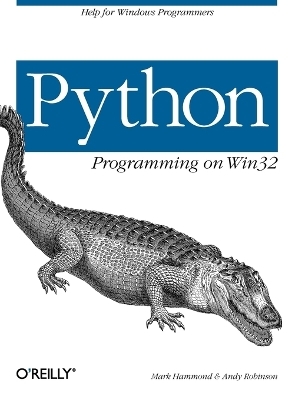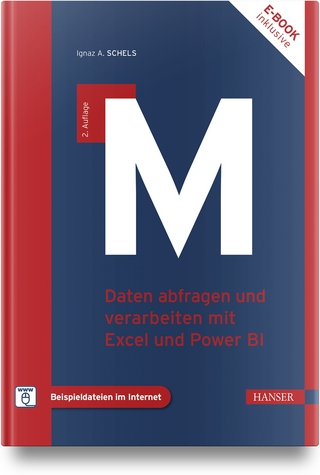Python Programming on WIN32
O'Reilly Media (Verlag)
978-1-56592-621-9 (ISBN)
- Lieferbar (Termin unbekannt)
- Versandkostenfrei innerhalb Deutschlands
- Auch auf Rechnung
- Verfügbarkeit in der Filiale vor Ort prüfen
- Artikel merken
Python is growing in popularity; based on download statistics, there are now over 450,000 people using Python, and more than 150,000 people using Python on Windows. Use of the language has been growing at about 40% per year since 1995, and there is every reason to believe that growth will continue. Despite Python's increasing popularity on Windows, Python Programming on Win32 is the first book to demonstrate how to use it as a serious Windows development and administration tool. Unlike scripting on Unix, Windows scripting involves integrating a number of components, such as COM or the various mail and database APIs, with the Win32 programming interface. While experienced Windows C++ programmers can find their way through the various objects, most people need some guidance, and this book is it. It addresses all the basic technologies for common integration tasks on Windows, explaining both the Windows issues and the Python code you need to glue things together.
Topics include: * The Python language and the PythonWin extensions * Building a GUI with COM * Adding a Macro language * Distributing the application * Client-side COM for output and data access * Integration with mail and other internet protocols * Managing users and drives This is a vital and unique book. Python Programming on Win32 is an excellent presentation of Windows application development and a solid illustration of how to use Python in the Windows environment.
Mark Hammond is an independent Microsoft Windows consultant working out of Melbourne, Australia. He studied computer science at the South Australian Institute of Technology (now the University of South Australia), and then worked with several large financial institutions in Australia. He started his consulting operation in 1995. Mark has produced many of the Windows extensions for Python, including PythonWin, Active Scripting, and Active Debugging support, and coauthored the COM framework and extensions. He is also a leading authority on Active Scripting and related technologies and has spoken on this subject at Microsoft?s three most recent Professional Developers conferences. Apart from being a father to his teenage daughter, having an interest in live music, and providing way-too-many free Python extensions, Mark has no life! Andy Robinson is a London-based consultant specializing in business analysis, object-oriented design, and Windows development. He studied physics and philosophy, then Japanese studies at Oxford. He spent a year in advertising in Tokyo, two more in investment banking, and a long spell as the finance director of a startup in the sports industry. Observing that in all these positions he always ended up having to rewrite software, he moved to full-time computer consulting four years ago. He is currently helping one of the world's largest fund managers to internationalize their systems to handle Asian languages, developing Python systems for financial analysis, and reporting. Back when Andy had spare time, his passions were track and field, and rock climbing. Right now his two sons, Tim and Harry, are taking up all of his time.
Preface. I. Introduction to Python. 1. What Is Python? Language Features Python as an Integration Tool Case Studies of Python Deployment The Python Community Installation and Setup Conclusion. 2. Python Language Review A Crash Course Conclusion References. 3. Python on Windows The Python Core on Windows The Python for Windows Extensions The Python Imaging Library (PIL) PyOpenGL Web Publishing Tools The mx Extensions Scientific Tools XML Conclusion. 4. Integrated Development Environments for Python The PythonWin IDE IDLE Conclusion. 5. Introduction to COM What It Is Using COM Objects from Python Implementing COM Objects with Python Globally Unique Identifiers Conclusion II. Building an Advanced Python Application. 6. A Financial Modeling Toolkit in Python Doubletalk A Crash Course in Accounting The Doubletalk Toolkit at Work Conclusion. 7. Building a GUI with COM Designing COM Servers A VB Client Writing a Delphi User Interface Conclusion. 8. Adding a Macro Language Dynamic Code Evaluation Making an Application Extensible Conclusion 9. Integration with Excel Client-Side COM and the Excel Object Model Excel Concluded Putting It All Together: Importing Financial Data Server-Side COM Again: Excel as a GUI Conclusion References. 10. Printed Output Business Requirements Automating Word Direct Output to the Printer with Windows PIDDLE: A Python Graphics API PostScript Portable Document Format Putting It Together: A High-Volume Invoicing System Conclusion References. 11. Distributing Our Application DCOM Conclusion II. Python on Windows Cookbook. 12. Advanced Python and COM Advanced COM Python and COM Using Automation Objects from Python Using Other COM Interfaces Error Handling Implementing COM Objects in Python Python and DCOM Conclusion. 13. Databases DAO, ADO, ODBC, OLEDB, and Other GBFLAs Python's Database API Getting at Your Data A Note on Speed Gadfly, the Pure Python Relational Database Data Laundering with Python A Three-Tier Architecture with Business Objects Conclusion References. 14. Working with Email SMTP and POP3 Microsoft Exchange/Outlook Conclusion. 15. Using the Basic Internet Protocols HTTP and HTML FTP NNTP Conclusion. 16. Windows NT Administration Working with Users and Groups Server and Share Information Rebooting a Machine Conclusion References. 17. Processes and Files Portable File Manipulation Native File Manipulation: The win32file Module Pipes Processes Conclusion. 18. Windows NT Services Services in Brief Controlling Services with Python Reading the Event Log Windows NT Performance Monitor Data Writing Services in Python Sample Service Written in Python Writing to the Event Log Providing Performance Monitor Information A Final Service Conclusion. 19. Communications Serial Communications Remote Access Services Sockets Other Communications Tools Conclusion References. 20. GUI Development Tkinter PythonWin wxPython. 21. Active Scripting Registering the Python Active Script Support Python and Popular Microsoft Applications Active Debugging How Active Scripting Works Active Script Hosting in Python Conclusion. 22. Extending and Embedding with Visual C++ and Delphi Python and Visual C++ |Simplified Wrapper and Interface Generator Python and Delphi Dynamic DLL Access References Conclusion IV. Appendixes A. Key Python Modules and Functions B. Win32 Extensions Reference C. The Python Database API Version 2.0 D. Threads Index
| Erscheint lt. Verlag | 29.2.2000 |
|---|---|
| Reihe/Serie | Animal Ser. |
| Verlagsort | Sebastopol |
| Sprache | englisch |
| Einbandart | kartoniert |
| Themenwelt | Informatik ► Betriebssysteme / Server ► Windows |
| Informatik ► Programmiersprachen / -werkzeuge ► Python | |
| ISBN-10 | 1-56592-621-8 / 1565926218 |
| ISBN-13 | 978-1-56592-621-9 / 9781565926219 |
| Zustand | Neuware |
| Haben Sie eine Frage zum Produkt? |
aus dem Bereich




